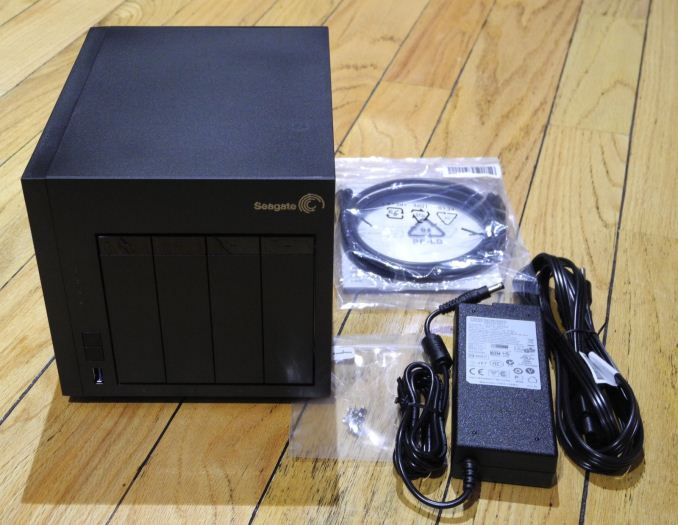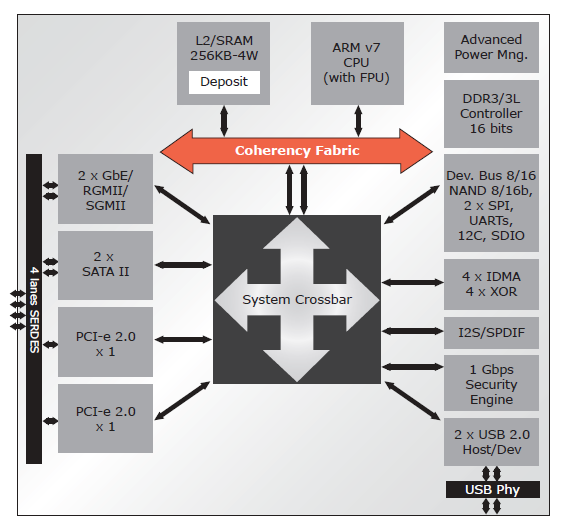Seagate NAS 4-Bay with Marvell ARMADA 370 Review
by Ganesh T S on July 24, 2014 8:30 AM ESTHardware Platform & Setup Impressions
The industrial design of the Seagate NAS 4-bay is strikingly different from the 2013 Business Storage NAS units. The fingerprint-magnetic surface has been discarded. In its place, we have an almost metallic looking chassis (which turns out to be completely plastic on closer inspection). The hot-swap bays are easily accessible in the front of the unit . The drive caddies themselves are tool-less ones, as long as 3.5" drives are used. There are screw slots for 2.5" drives on the caddies. Apart from the main unit, the package consists of the following:
- 2M Cat 5E Ethernet cable
- 90 W (19V @ 4.7A) external power supply with US power cord
- Getting started guide / warranty card
- Screws for 2.5" drive installation
The chassis may come with the drives preconfigured in SimplyRAID (RAID-5, essentially) for non-diskless configurations. In terms of chassis I/O, we have a USB 3.0 port on the front (beneath the power and backup buttons) and another one on the rear side. The rear face also has two network ports, a power inlet and a recessed reset button. The non-diskless units ship with the Seagate NAS HDDs.
The unit was also quite straightforward to take apart (except for the presence of some Torx screws on the rear side). On the inside, we were quite happy to see that Seagate had decided to continue LaCie's tradition of installing a Noctua fan (NF-P12). It is able to keep an excellent thermal profile while being on the quiet side. Getting further inside the chassis, we find Seagate's code-name, 'Dart', for the NAS platform. The ARMADA 370 SoC is itself under a heat sink, but the ASMedia ASM1042A, Marvell 88SE9170 and two Marvell 88E1518 chips are visible readily on the board.
Platform Analysis
The ARMADA 370 block diagram is provided below. The lspci command in the SSH window provides some interesting information, which is corroborated by the teardown pictures in the above gallery.
[admin@Seagate-D4 /]$ lspci -q
00:01.0 PCI bridge: Marvell Technology Group Ltd. Device 7846
00:02.0 PCI bridge: Marvell Technology Group Ltd. Device 7846
01:00.0 IDE interface: Marvell Technology Group Ltd. 88SE9170 PCIe SATA 6Gb/s Controller (rev 12)
02:00.0 USB controller: ASMedia Technology Inc. ASM1042A USB 3.0 Host Controller
The Marvell 88SE9170 takes up one PCIe 2.0 lane and provides support for two SATA ports. The ASM1042A takes up the other PCIe lane and provides support for the two USB 3.0 ports in the system. The 88E1518 chips are Alaska parts which provide 10/100/1000BASE-T PHYs with RGMII support that interface to the two GbE ports in the SoC. This leads us to believe that the ARMADA 370 part being used in the NAS 4-bay is actually the 88F6710, which supports 2x GbE, 2x PCIe 2.0 x1 and 2x SATA simultaneously.
Setup & Usage
After connection to the network, the unit obtains a DHCP address (even in diskless mode) and could be setup using the web UI at http://<NAS-IP>. The Seagate Network Assistant desktop software is also able to track the available Seagate NAS units (initialized or not) on the network (in case one is not able to determine the DHCP IP obtained by the unit from the router side). Setup proceeds after insertion of at least one disk into the unit. If the unit is able to reach the Internet, it checks, downloads and installs the latest firmware update. Letting the process run its due course soon lands us in the minimal UI (as shown in the gallery below).
The Device Manager option takes us back to the familiar NAS OS UI. Even in this minimal interface, we have support for multi-tasking. The drop down menu at the top right shows the currently running apps and also provides a way to close them, if necessary. The App Manager lets users install various apps such as BitTorrent Sync, Elephant Drive, WordPress etc. The selection right now is quite minimal, but that should improve over time.
The device manager options are quite similar to what we saw in the Seagate Business Storage 8-bay Rackmount review. The interesting aspects are that SSH access is now available, and we have an option to install SDrive from the UI. These are all welcome changes which can help Seagate achieve feature parity with the competitors.
We also have some screenshots of the storage and volume handling aspects of NAS OS. Our full test process of starting with one drive, migrating to RAID-1, adding another drive to migrate to RAID-5 and yet another one to expand the RAID-5 volume using a total of 4x 4 TB WD Re drives successfully completed with no issues whatsoever.
We simulated drive failure by yanking out one of the drives during data transfer. The operations from the client didn't face any hiccups, but the NAS UI immediately reported the trouble (alerts can be configured). Inserting a new drive allowed for rebuild. The various steps are shown in the gallery above.














































19 Comments
View All Comments
Arbie - Thursday, July 24, 2014 - link
Didn't see thermals mentioned. Seagate goes for record-setting internal temps by totally sealing their drives in plastic. I have several GoFlex multi-TB units that, out of the box, exceed their max rated limits! It seems impossible that a company that can build a modern hard drive can't produce a ventilated plastic box to house it. At least I thought it was impossible, but technology advances....Yeah I know these are different animals but they still say "Seagate" on them, and those incompetent packaging engineers must have moved on to some other project. Could be this one.
Ref: http://www.anandtech.com/show/3858/the-worlds-firs...
and probably many other web comments by now.
BTW the fix on the GoFlex is to rip half the cover off, and hold the remaining half on with a rubber band. Looks real nice.
JeffFlanagan - Thursday, July 24, 2014 - link
I was considering getting three or four of these to replace my somewhat flaky Unraid server, but Arbie's comment makes me worry that this will be drive-destroying junk.Ganesh, can you tell us about any thermal issues?
DanNeely - Thursday, July 24, 2014 - link
This design includes a 120mm fan. While measurements would be nice, I doubt this design has the same problem as the goflex enclosure.woggs - Thursday, July 24, 2014 - link
The pics on page 2 show the fan but no other vent holes for air flow. Where does the air from the fan go? Are there bottom vent holes we can't see?MichaelD - Thursday, July 24, 2014 - link
The fan pulls air through the chassis from front to back. The air enters through the spaces around the drive sleds and is pulled through/over the drives before being pushed out the perforated rear panel.I've been looking to get a NAS device to replace the W7 box/HW RAID card setup I have running at home as a NAS. I built that box 3 years ago to replace the SOHO NAS JUNK that was for sale at that time. I.E. under $600 or so.
This box looks promising...but still, the storage format is not compatible with Windows. If the NAS itself fails, I have to wait until a replacement NAS is purchased to see if my data is there, and that worries me.
MichaelD - Thursday, July 24, 2014 - link
Just saw that even though it's got two GbE ports, this device does not support Link Aggregation. A real shame. Not a deal-breaker for me but it's nit to pick.MadMan007 - Thursday, July 24, 2014 - link
It depends on the NAS drive file system actually. There are ext4 drivers for Windows that enable read/write of ext4 volumes. I have read that people are able to pull a drive from a RAID1 and read it on a Windows machine...perhaps it depends on the NAS vendor as well though.ganeshts - Thursday, July 24, 2014 - link
This unit's lineage is not related to the GoFlex, rather, it is from LaCie (the use of Noctua fans, for example).I am very happy with the thermal performance. All our evaluation was done with the WD Re drives (known for not being very 'cool'), and never once did the temperatures go above 50 C in our stress tests.
BMNify - Thursday, July 24, 2014 - link
seriously, how can you keep flogging the crap ARMADA 370 SoC in a NAS as a good investment, tindustrial hey are far lower spec than even a A8 in data throughput and the ports are second rate add-on's for a soc that cant cope.....even an old 5.4" single board computer with a cheap case would be far more forgiving of data throughput, http://www.abigo4u.com/review/product/list/id/2136...
LS-576TXD 5.25" Embedded board with Intel QM77 w/6 x Giga LAN
or one of the newer 3.5" smb's would give far better return on investmant, just bung freenas on there and be far better supported.
name99 - Thursday, July 24, 2014 - link
Dude, just accept that different people have different desires and needs.Personally I don't see the point of these NAS boxes --- I can (and do) create much the same thing by hooking up a bunch of external drives to an old Mac and using OSX's soft RAID. Meets my needs, may not meet yours, especially if your needs demand RAID5 or live disk replacement.
Likewise some other people's NEEDs (not desires, NEEDs) are "absolutely trivial installation", or "comes in a single box that can easily be moved, with no bits hanging out".
You're like the salesman who, asked "please show me the laptops department" starts ranting about "you don't want a laptop, you want a tablet. Here, let me show you our fine selection of tablets."